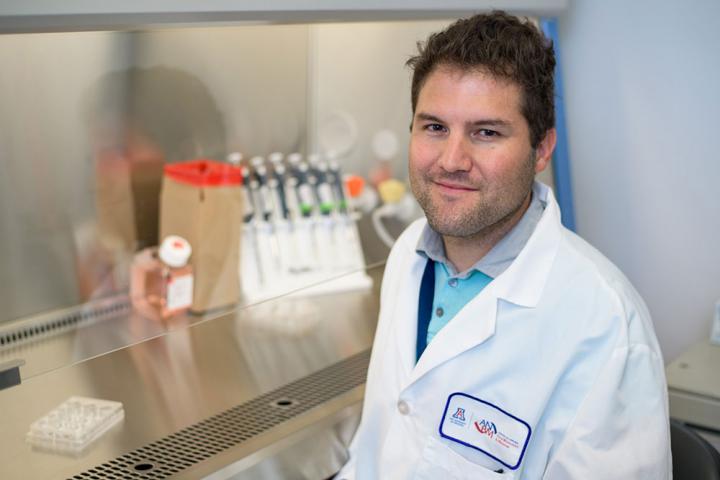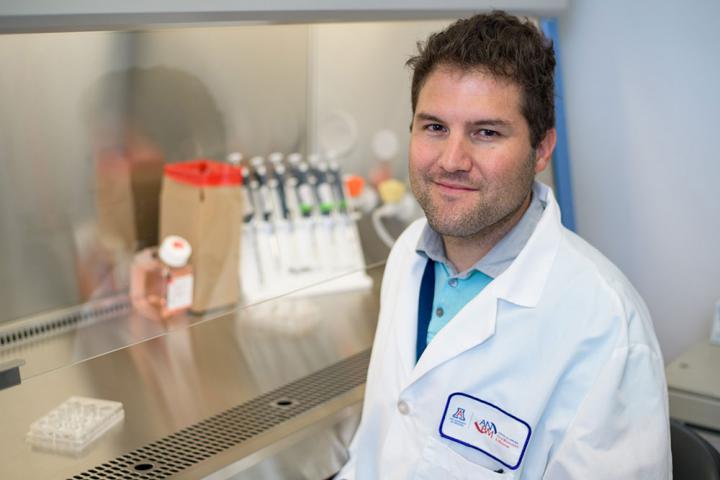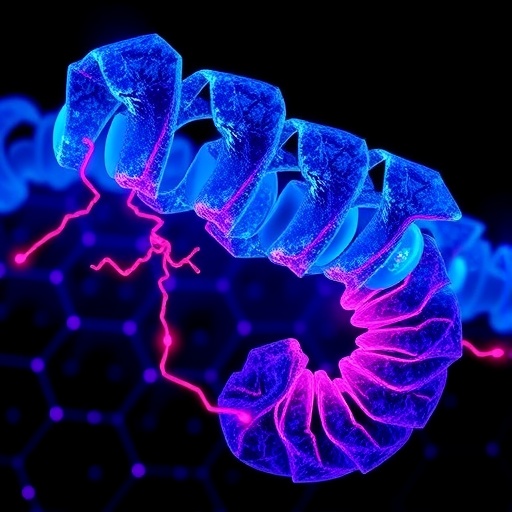
Credit: Sun Czar Belous, UA College of Medicine – Phoenix
Researchers at the University of Arizona College of Medicine – Phoenix are attempting to create a better diagnostic test for radiation exposure that potentially could save thousands of lives.
Jerome Lacombe, PhD, an assistant professor and researcher at the UA Center for Applied NanoBioscience and Medicine, recently published a peer-reviewed study in the Public Library of Science journal PLOS ONE.
His study compiled a list of genes reported to be affected by external ionizing radiation (IR), and assessed their performance as possible biomarkers that could be used to calculate the amount of radiation absorbed by the human body.
"In the case of a nuclear event, a lot of people can be radiated," Dr. Lacombe said. "That is why it's so important that we can quickly and accurately assess the absorbed radiation so we can give patients the proper medical treatment as fast as possible."
Dr. Lacombe hopes to develop a radiation test that is less labor intensive and takes only two days for results.
"If you have thousands of people and only two days to screen everyone, it would be almost impossible to do this with the current exposure test," Dr. Lacombe said. "With immediate care and the right diagnostics, people could have a better chance of survival."
Dr. Lacombe, who worked with researchers from Columbia University Medical Center and Texas A&M Engineering Experiment Station, analyzed published studies from 1978 through 2017 that identified more than 10,000 unique responsive genes in human blood after external IR.
Although many studies have tried to correlate gene expression after radiation exposure, their sample sizes have been small because of expense and the time it takes to test the genes. By combining 24 studies, Dr. Lacombe and his team investigated a large data set using a standardized data extraction method and various statistical algorithms to find a list of robust candidate biomarkers.
This marks the first time a team has combined all these biomarkers and attempted to run a diagnostic assay to determine radiation exposure, Dr. Lacombe said.
"There is no validated signature for biodosimetry (the measurement of biological response for radiation dose)," Dr. Lacombe said. "There is no validated gene signature to assess the radiation dose. We hope this paper can begin to identify these biomarkers and confirm genes that are radiation responsive."
###
Other study authors were Frederic Zenhausern, PhD, director, UA Center for Applied NanoBioscience and Medicine; Chao Sima, Center for Bioinformatics and Genomic Systems Engineering, Texas A&M Engineering Experiment Station; and Sally A. Amundson, Center for Radiological Research, Columbia University Medical Center.
The authors received financial support from the Center for High-Throughput Minimally-Invasive Radiation Biodosimetry (National Institute of Allergy and Infectious Diseases, grant No. U19 AI067773).
The UA Center for Applied NanoBioscience and Medicine is on the forefront of developing radiation treatment and diagnostics. In collaboration with Columbia University, the Translational Genomics Research Institute (TGen) and Georgetown University, the center has been co-sponsored by the National Institute of Allergy and Infectious Diseases for 14 years. The partnerships have resulted in leading the development of gene expression-based biodosimetry technology platforms sponsored by several contracts with the Biomedical Advanced Research and Development Authority (BARDA).
The center has expanded its areas of research applications in radiation biology, including:
- Radio-sensitizing drugs: Oncologists may be able to prescribe a cancer patient a drug that could enhance the effect of radiation on their tumor. The lab investigates natural compounds found in plants that show promise in halting the growth of cancer cells.
- Radiotherapy treatments: The lab is looking into the effects of a high single radiation dose versus the same dose delivered in several fractions. Now, patients being treated for breast cancer usually receive about 30 fractions of two-grade doses. With improvements in technology, clinicians try to limit the number of fractions and therefore increase the radiation dose for each of them.
- Human organ-on-a-chip and microbiomes: Scientists are attempting to investigate radiation response through various novel devices, such as the "gut-on-a-chip." This technology allows researchers to analyze the complex interactions between human cells and microbial ecosystems, predicting the effect of space radiation on the human gut during long missions beyond low Earth orbit.
- Engineered tissue models: The lab is developing a plant-based platform that provides cellulose scaffolds by treating leaves with detergents to remove all traces of plant cells, DNA and proteins. The resulting scaffold then is used as a 3D matrix and repopulated with various human cells to create a vascularized cancer tumor model so the role of the microenvironment in tumor radiation response can be investigated.
About the UA College of Medicine – Phoenix
Founded in 2007, the University of Arizona College of Medicine – Phoenix inspires and trains exemplary physicians, scientists and leaders to optimize health and health care in Arizona and beyond. By cultivating collaborative research locally and globally, the college accelerates discovery in a number of critical areas — including cancer, stroke, traumatic brain injury and cardiovascular disease. Championed as a student-centric campus, the college has graduated 433 physicians, all of whom received exceptional training from nine clinical partners and 1,800 diverse faculty members. As the anchor to the Phoenix Biomedical Campus, which is projected to have an economic impact of $3.1 billion by 2025, the college prides itself on engaging with the community, fostering education, inclusion, access and advocacy. For more information, please visit phoenixmed.arizona.edu
Media Contact
Teresa Joseph
[email protected]
602-827-2657
http://uahs.arizona.edu/
Original Source
http://opa.uahs.arizona.edu/newsroom/news/2018/ua-researchers-preparing-quick-radiation-diagnostic-test-case-nuclear-disaster





